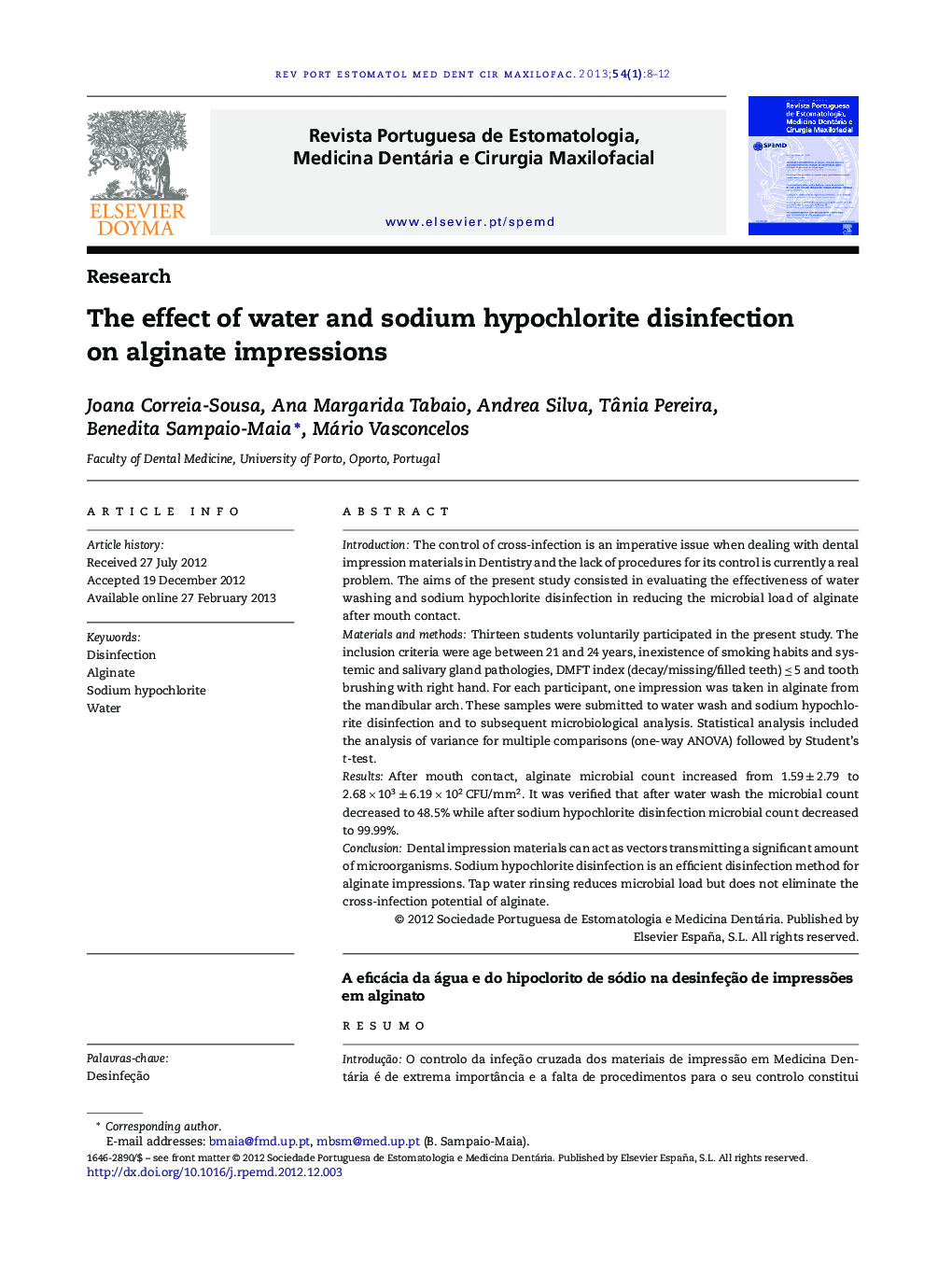| کد مقاله | کد نشریه | سال انتشار | مقاله انگلیسی | نسخه تمام متن |
|---|---|---|---|---|
| 3173485 | 1200018 | 2013 | 5 صفحه PDF | دانلود رایگان |

IntroductionThe control of cross-infection is an imperative issue when dealing with dental impression materials in Dentistry and the lack of procedures for its control is currently a real problem. The aims of the present study consisted in evaluating the effectiveness of water washing and sodium hypochlorite disinfection in reducing the microbial load of alginate after mouth contact.Materials and methodsThirteen students voluntarily participated in the present study. The inclusion criteria were age between 21 and 24 years, inexistence of smoking habits and systemic and salivary gland pathologies, DMFT index (decay/missing/filled teeth) ≤ 5 and tooth brushing with right hand. For each participant, one impression was taken in alginate from the mandibular arch. These samples were submitted to water wash and sodium hypochlorite disinfection and to subsequent microbiological analysis. Statistical analysis included the analysis of variance for multiple comparisons (one-way ANOVA) followed by Student's t-test.ResultsAfter mouth contact, alginate microbial count increased from 1.59 ± 2.79 to 2.68 × 103 ± 6.19 × 102 CFU/mm2. It was verified that after water wash the microbial count decreased to 48.5% while after sodium hypochlorite disinfection microbial count decreased to 99.99%.ConclusionDental impression materials can act as vectors transmitting a significant amount of microorganisms. Sodium hypochlorite disinfection is an efficient disinfection method for alginate impressions. Tap water rinsing reduces microbial load but does not eliminate the cross-infection potential of alginate.
ResumoIntroduçãoO controlo da infeção cruzada dos materiais de impressão em Medicina Dentária é de extrema importância e a falta de procedimentos para o seu controlo constitui atualmente um problema real. Os objetivos do presente trabalho consistiram na avaliação da eficácia da lavagem com água e da desinfeção com hipoclorito de sódio na redução da carga microbiana do alginato após o contacto com a cavidade oral.Material e métodosTreze estudantes participaram voluntariamente no estudo. Os critérios de inclusão foram a idade entre 21-24 anos, ausência de hábitos tabágicos e de patologias sistémicas e das glândulas salivares, índice CPO (dentes cariados, perdidos e obturados) ≤ 5 e escovagem com a mão direita. Uma impressão em alginato da arcada mandibular foi obtida de cada participante. As amostras foram submetidas aos métodos de lavagem/desinfeção e, posteriormente, à análise microbiológica. Os testes ANOVA para comparações múltiplas e o teste t de student foram utilizados como ferramentas para a análise estatística.ResultadosO alginato após o contacto com a cavidade oral apresentou uma carga microbiana de 2,68 × 103 ± 6,19 × 102 CFU/mm2. A simples passagem por água corrente diminui a carga microbiana em 48,5%, enquanto que a desinfeção com hipoclorito de sódio diminui a carga microbiana em 99,99%.ConclusãoOs materiais de impressão podem ser veículos de transmissão de microrganismos. O hipoclorito de sódio é um método de desinfeção eficaz para as impressões em alginato. Apesar da lavagem com água corrente reduzir significativamente a carga microbiana, não elimina o potencial de infeção cruzada das impressões em alginato.
Journal: Revista Portuguesa de Estomatologia, Medicina Dentária e Cirurgia Maxilofacial - Volume 54, Issue 1, January–March 2013, Pages 8–12